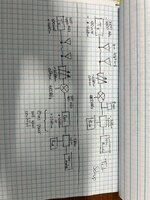Zebxcore
Newbie level 6

Good day fellas,
I designed the following board which includes a bias tee, gain amp, and an attenuator which I am still working on since it requires me to program the main IC on an external board to control it via I2C. In the meantime, I would like to make it work and test on it. What I came up with is what you see, a copper strand out from a coaxial cable, of similar width to a 50 ohm trace to short the I/O of the attenuator. At higher frequencies, around 1.5GHz and up, the response is obviously very wavy and bad but I am only concern up to 1GHz. Has anyone a better idea to short it without using copper tape? (I dont have any around).

Also, with the little testing I have done so far, our signal seems to have added noise to it. I calculated the noise from the LNA (its a HMC636 or HMC589 depending on gain needed) and it seemed to be ok. However, the SNR difference at the RX with and without the amp is astronomical even though the power levels seems good. TX signal is about 18dBm onto a peak antenna with gain of about 2-3dBi over 30-40ft. All this at around 3.4GHz. I know AT&T bought a big portion of the spectrum for low 5G implementation but I am not sure if that could have anything to do with added noise close to 3.5GHz.
Thanks for any help you guys can provide me with
I designed the following board which includes a bias tee, gain amp, and an attenuator which I am still working on since it requires me to program the main IC on an external board to control it via I2C. In the meantime, I would like to make it work and test on it. What I came up with is what you see, a copper strand out from a coaxial cable, of similar width to a 50 ohm trace to short the I/O of the attenuator. At higher frequencies, around 1.5GHz and up, the response is obviously very wavy and bad but I am only concern up to 1GHz. Has anyone a better idea to short it without using copper tape? (I dont have any around).
Also, with the little testing I have done so far, our signal seems to have added noise to it. I calculated the noise from the LNA (its a HMC636 or HMC589 depending on gain needed) and it seemed to be ok. However, the SNR difference at the RX with and without the amp is astronomical even though the power levels seems good. TX signal is about 18dBm onto a peak antenna with gain of about 2-3dBi over 30-40ft. All this at around 3.4GHz. I know AT&T bought a big portion of the spectrum for low 5G implementation but I am not sure if that could have anything to do with added noise close to 3.5GHz.
Thanks for any help you guys can provide me with


